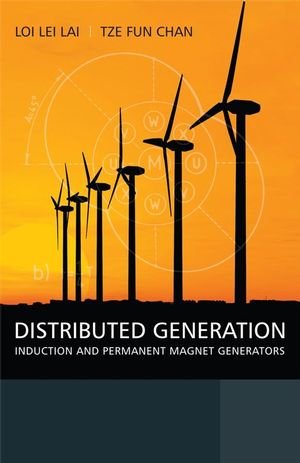Distributed Generation: Induction and Permanent Magnet GeneratorsISBN: 978-0-470-06208-1
Hardcover
262 pages
November 2007, Wiley-IEEE Press
 This is a Print-on-Demand title. It will be printed specifically to fill your order. Please allow an additional 10-15 days delivery time. The book is not returnable.
|
||||||
Foreword xi
Preface xiii
Acknowledgements xvii
About the Authors xix
1 Distributed Generation 1
1.1 Introduction 1
1.2 Reasons for DG 1
1.3 Technical Impacts of DG 3
1.3.1 DG Technologies 3
1.3.2 Thermal Issues 5
1.3.3 Voltage Profile Issues 5
1.3.4 Fault-Level Contributions 7
1.3.5 Harmonics and Interactions with Loads 7
1.3.6 Interactions Between Generating Units 8
1.3.7 Protection Issues 8
1.4 Economic Impact of DG 9
1.5 Barriers to DG Development 10
1.6 Renewable Sources of Energy 11
1.7 Renewable Energy Economics 12
1.8 Interconnection 15
1.8.1 Interconnection Standardization 15
1.8.2 Rate Design 15
1.9 Recommendations and Guidelines for DG Planning 16
1.10 Summary 18
2 Generators 21
2.1 Introduction 21
2.2 Synchronous Generator 21
2.2.1 Permanent Magnet Materials 22
2.2.2 Permanent Magnet Generator 23
2.3 Induction Generator 28
2.3.1 Three-Phase IGs and SEIGs 29
2.3.2 Single-Phase IGs and SEIGs 30
2.4 Doubly Fed Induction Generator 31
2.4.1 Operation 31
2.4.2 Recent Work 33
2.5 Summary 34
3 Three-Phase IG Operating on a Single-Phase Power System 41
3.1 Introduction 41
3.2 Phase Balancing using Passive Circuit Elements 41
3.2.1 Analysis of IG with Phase Converters 41
3.2.2 Phase Balancing Schemes 43
3.2.3 Case Study 45
3.2.4 System Power Factor 47
3.2.5 Power and Efficiency 49
3.2.6 Operation with Fixed Phase Converters 50
3.2.7 Summary 51
3.3 Phase Balancing using the Smith Connection 52
3.3.1 Three-Phase IG with the Smith Connection 52
3.3.2 Performance Analysis 54
3.3.3 Balanced Operation 55
3.3.4 Case Study 58
3.3.5 Effect of Phase Balancing Capacitances 61
3.3.6 Dual-Mode Operation 65
3.3.7 Summary 66
3.4 Microcontroller-Based Multi-Mode Control of SMIG 67
3.4.1 Phase Voltage Consideration 67
3.4.2 Control System 67
3.4.3 Practical Implementation 71
3.4.4 Experimental Results 72
3.4.5 Summary 75
3.5 Phase Balancing using a Line Current Injection Method 77
3.5.1 Circuit Connection and Operating Principle 77
3.5.2 Performance Analysis 78
3.5.3 Balanced Operation 80
3.5.4 Case Study 82
3.5.5 Summary 91
4 Finite Element Analysis of Grid-Connected IG with the Steinmetz Connection 93
4.1 Introduction 93
4.2 Steinmetz Connection and Symmetrical Components Analysis 94
4.3 Machine Model 95
4.4 Finite Element Analysis 96
4.4.1 Basic Field Equations 96
4.4.2 Stator Circuit Equations 97
4.4.3 Stator EMFs 99
4.4.4 Rotor Circuit Model 99
4.4.5 Comments on the Proposed Method 102
4.5 Computational Aspects 103
4.6 Case Study 104
4.7 Summary 109
5 SEIGs for Autonomous Power Systems 111
5.1 Introduction 111
5.2 Three-Phase SEIG with the Steinmetz Connection 111
5.2.1 Circuit Connection and Analysis 111
5.2.2 Solution Technique 114
5.2.3 Capacitance Requirement 115
5.2.4 Computed and Experimental Results 117
5.2.5 Capacitance Requirement on Load 121
5.2.6 Summary 123
5.3 SEIG with Asymmetrically Connected Impedances and Excitation Capacitances 123
5.3.1 Circuit Model 124
5.3.2 Performance Analysis 124
5.3.3 Computed and Experimental Results 125
5.3.4 Modified Steinmetz Connection 126
5.3.5 Simplified Steinmetz Connection 133
5.3.6 Summary 135
5.4 Self-regulated SEIG for Single-Phase Loads 136
5.4.1 Circuit Connection and Analysis 136
5.4.2 Effect of Series Compensation Capacitance 138
5.4.3 Experimental Results and Discussion 143
5.4.4 Effect of Load Power Factor 147
5.4.5 Summary 149
5.5 SEIG with the Smith Connection 150
5.5.1 Circuit Connection and Operating Principle 150
5.5.2 Performance Analysis 151
5.5.3 Balanced Operation 152
5.5.4 Results and Discussion 153
5.5.5 Summary 159
6 Voltage and Frequency Control of SEIG with Slip-Ring Rotor 161
6.1 Introduction 161
6.2 Performance Analysis of SESRIG 162
6.3 Frequency and Voltage Control 165
6.4 Control with Variable Stator Load 166
6.5 Practical Implementation 168
6.5.1 Chopper-Controlled Rotor External Resistance 168
6.5.2 Closed-Loop Control 169
6.5.3 Tuning of PI Controller 170
6.5.4 Dynamic Response 170
6.6 Summary 173
7 PMSGs For Autonomous Power Systems 175
7.1 Introduction 175
7.2 Principle and Construction of PMSG with Inset Rotor 175
7.3 Analysis for Unity-Power-Factor Loads 177
7.3.1 Analysis Using the Two-Axis Model 177
7.3.2 Design Considerations 180
7.3.3 Computed Results 182
7.3.4 Experimental Results 183
7.3.5 Summary 184
7.4 A Comprehensive Analysis 185
7.4.1 Basic Equations and Analysis 185
7.4.2 Conditions for Zero Voltage Regulation 188
7.4.3 Extremum Points in the Load Characteristic 190
7.4.4 Power–Load Angle Relationship 191
7.4.5 The Saturated Two-Axis Model 192
7.4.6 Summary 194
7.5 Computation of Synchronous Reactances 194
7.5.1 Analysis Based on FEM 194
7.5.2 Computation of Xd and Xq 196
7.5.3 Computed Results 197
7.5.4 Summary 201
7.6 Analysis using Time-Stepping 2-D FEM 201
7.6.1 Machine Model and Assumptions 201
7.6.2 Coupled Circuit and Field Analysis 202
7.6.3 Magnetic Saturation Consideration 205
7.6.4 Computed Results 207
7.6.5 Experimental Verification 211
7.6.6 Summary 212
8 Conclusions 215
8.1 Accomplishments of the Book 215
8.2 Future Work 217
AppendixA Analysis for IG and SEIG 219
A.1 Symmetrical Components Equations for IG 219
A.2 Positive-Sequence and Negative-Sequence Circuits of IG 220
A.3 Vp and Vn for IG with Dual-Phase Converters 221
A.4 Derivation of Angular Relationship 223
A.5 Input Impedance of SEIG with the Steinmetz Connection 224
Appendix B The Method of Hooke and Jeeves 227
AppendixC A Note on the Finite Element Method [1] 229
C.1 Energy Functional and Discretization 229
C.2 Shape Functions 230
C.3 Functional Minimization and Global Assembly 233
Reference 234
AppendixD Technical Data of Experimental Machines 235
D.1 Machine IG1 235
D.2 Machine IG2 236
D.3 Prototype PMSG with Inset Rotor 236
Index 239



